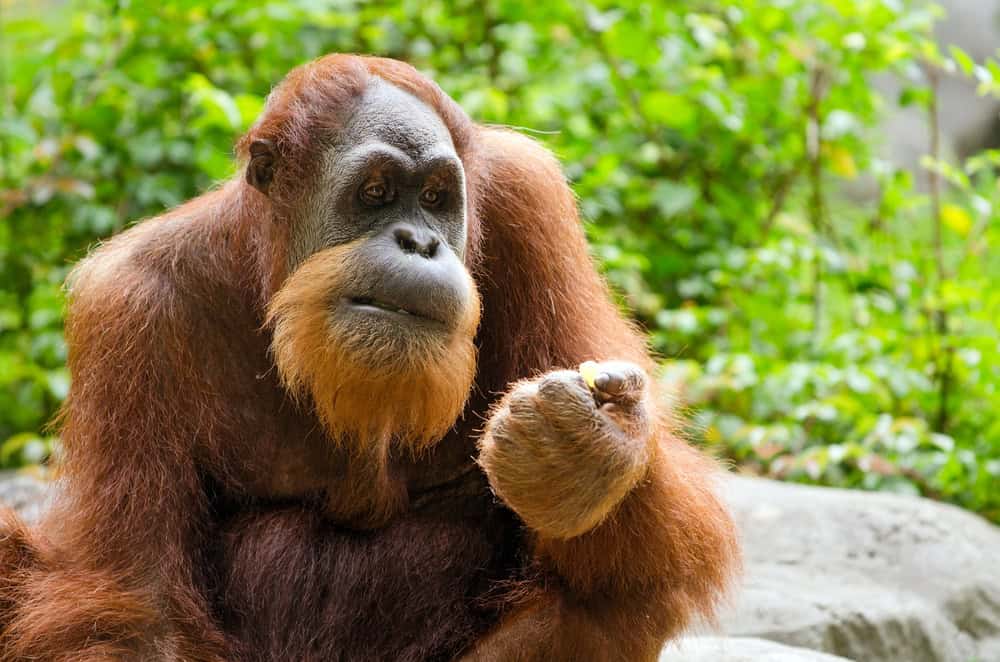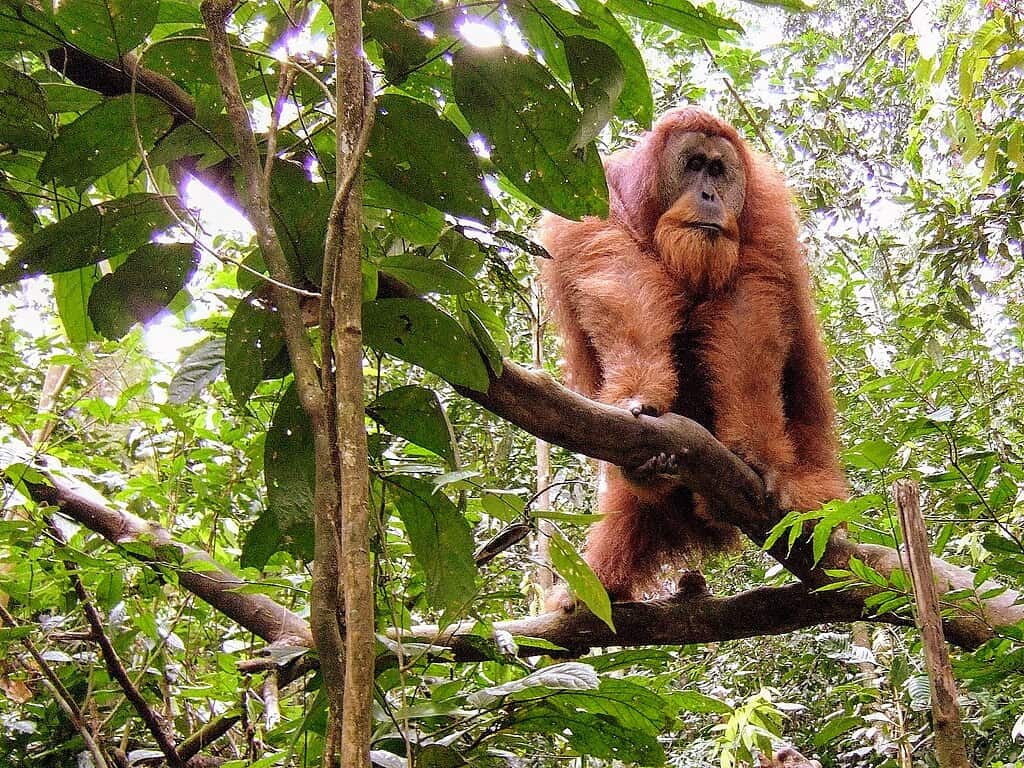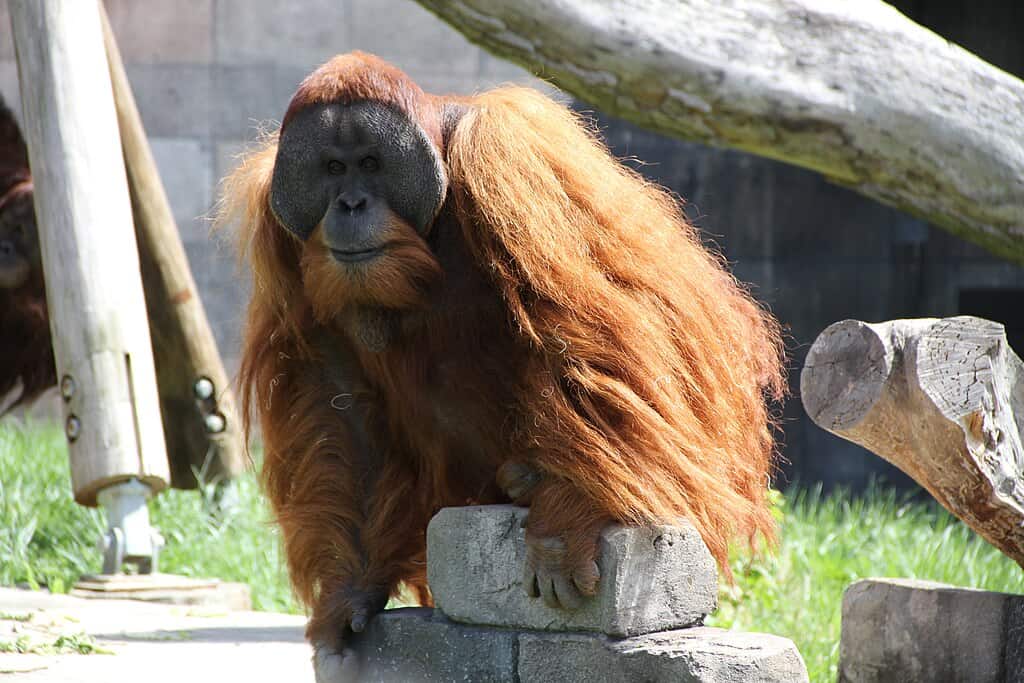Deep in the lush rainforests of Borneo and Sumatra, orangutan mothers perform a remarkable daily ritual that showcases their intelligence, dedication to their young, and advanced survival skills. Every single evening, as daylight fades through the dense canopy, female orangutans engage in a sophisticated construction project – building an entirely new sleeping nest from scratch. This isn’t merely an interesting behavioral quirk; it represents one of the most advanced examples of tool use and environmental manipulation in the animal kingdom outside of humans. The nightly nest-building ritual reveals profound insights about orangutan cognition, parenting strategies, and how these critically endangered great apes have adapted to their arboreal lifestyle over millions of years of evolution.
The Evolutionary Significance of Nest Building

Nest building among great apes evolved as a crucial survival adaptation. For orangutans specifically, these elaborate sleeping platforms represent the most complex and sophisticated nest structures created by any non-human animal. Unlike birds that might maintain a single nest for an entire season, orangutans have evolved to create fresh nests daily, a behavior that scientists believe developed over millions of years to provide protection from predators, parasites, and environmental conditions.
This daily construction behavior distinguishes orangutans from many other primates and represents a fascinating example of how evolution has shaped unique behavioral adaptations. The ability to quickly and efficiently transform forest materials into secure sleeping platforms demonstrates the remarkable cognitive flexibility that has allowed orangutans to thrive in their challenging rainforest environment. Each new nest serves not only as a comfortable bed but as a testament to the evolutionary pressures that have shaped orangutan behavior over countless generations.
The Architecture of Orangutan Nests

Orangutan nests are marvels of natural engineering. Typically constructed 15 to 30 meters above the ground in the forest canopy, these structures begin with the orangutan selecting a suitable foundation tree with sturdy, forked branches. The animal then bends, breaks, and weaves smaller branches to create a platform roughly 3 to 5 feet in diameter. Softer vegetation, including leaves, small twigs, and sometimes vines, is then layered atop this foundation to create a comfortable, mattress-like sleeping surface. Some orangutans even add a “pillow” of bundled leaves and a “blanket” or “roof” layer for additional comfort and protection.
What makes these structures particularly impressive is that they’re engineered to support the significant weight of an adult orangutan (which can reach up to 200 pounds for males) while remaining flexible enough to cradle the body comfortably. The construction typically takes between 5 to 10 minutes for an experienced adult female, showcasing the efficiency with which these animals can transform raw forest materials into functional architecture. Research has found that orangutans select specific tree species for their nests, demonstrating botanical knowledge and material preference in their building practices.
Daily Rebuilding: A Unique Maternal Strategy

The practice of building a new nest every night is particularly important for orangutan mothers, who may share their nests with dependent offspring for up to 8 years – the longest mother-child dependency period of any animal outside humans. This daily rebuilding serves several critical functions in the maternal care strategy. Fresh nests eliminate parasites that might otherwise accumulate in permanent sleeping structures, protecting vulnerable young orangutans from disease. The nightly construction also ensures structural integrity, as yesterday’s nest may have weakened from exposure to rain, wind, or the orangutan’s own weight.
For mothers with young, nest construction represents an essential parenting investment. Each new nest must be sturdy enough to support both mother and offspring, positioned appropriately for safety, and constructed with materials that provide proper comfort for sensitive young. Orangutan mothers have been observed testing branch strength more thoroughly when carrying infants, demonstrating how maternal responsibilities influence construction practices. This daily investment in creating safe sleeping environments represents one of the many ways orangutan mothers provide exceptional care for their slow-developing young.
Teaching the Next Generation

The nightly nest-building ritual serves another crucial function: education. Young orangutans learn nest-building skills by observing their mothers over many years. Researchers have documented a clear progression as young orangutans develop these skills. At around one year old, infants begin playfully manipulating nest materials while their mothers construct the actual nest. By age three or four, juveniles attempt to build simple “practice nests” near their mothers but still sleep in the maternal nest. Not until age six or seven do young orangutans consistently build and sleep in their own nests.
This extended learning period highlights how nest building represents a complex skill requiring years of observation and practice to master. The quality of nests improves gradually with age and experience, suggesting that building techniques are refined over time. Some researchers have even identified regional variations in nest-building styles, suggesting that specific techniques may be culturally transmitted between generations within particular orangutan populations – one of many examples of cultural learning documented in these remarkable apes.
The Mother-Infant Bond in the Nest

The orangutan nest serves as a crucial environment for strengthening the mother-infant bond that defines orangutan development. Unlike more social great apes like chimpanzees, orangutans live relatively solitary lives, making the mother-infant relationship particularly intense and significant. Within the intimate space of the nightly nest, mothers nurse their young, engage in grooming behaviors, and provide the physical contact essential for an infant’s psychological development. These nests essentially function as nurseries where critical social learning occurs.
Research has revealed that orangutan mothers and their young engage in sophisticated communication while in their nests, including facial expressions, vocalizations, and tactile signals that strengthen their bond. The security of a well-built nest allows for relaxed social interaction away from potential threats. Young orangutans learn essential life skills during these quiet evening and early morning hours spent in close proximity to their mothers. The nest thus serves not just as physical protection but as a social space where the foundation of orangutan development is established through maternal care and teaching.
Ecological Impact of Nest Building

The daily nest-building behavior of orangutans has significant ecological implications for their rainforest habitat. With each adult orangutan constructing approximately 365 nests annually, these great apes serve as important architects of forest structure. The selective breaking of branches creates small canopy gaps that allow sunlight to reach lower forest levels, potentially increasing plant diversity. When branches are broken but remain attached to trees, they often sprout new growth, altering local vegetation patterns.
Scientists studying forest ecology have found that areas with healthy orangutan populations show distinctive patterns of vegetation regrowth and canopy structure. The discarded nests themselves decompose and provide microhabitats for insects and other invertebrates, contributing to nutrient cycling within the ecosystem. Researchers now recognize orangutans as “ecosystem engineers” whose daily construction activities help maintain forest health and biodiversity. This understanding adds another dimension to conservation efforts, as protecting orangutans also means preserving their ecological functions within Southeast Asian rainforests.
Adapting to Environmental Challenges

Orangutan nest-building behavior shows remarkable adaptability to environmental conditions. During rainy seasons, mothers construct nests with more elaborate “roofs” created by weaving together leafy branches to form waterproof shelters. In areas with higher predator populations, nests tend to be built higher in the canopy and in trees that are more difficult to climb. When temperatures drop, orangutans have been observed creating thicker, more insulated nests with additional layers of vegetation.
This adaptability extends to habitat disruption as well. In areas affected by logging or forest fragmentation, orangutans demonstrate flexibility by building nests in unusual tree species or even occasionally on the ground when suitable trees are unavailable – though this represents a last resort that increases vulnerability to predators. Research in disturbed forests has shown that orangutan mothers become even more selective about nest sites when habitat quality declines, often traveling further to find suitable trees for their nightly constructions. This adaptability showcases the cognitive flexibility that has helped orangutans survive in rapidly changing landscapes, though there are limits to how much habitat disruption they can tolerate.
Nest Building as a Window into Cognition

For primatologists and cognitive scientists, orangutan nest construction provides valuable insights into these apes’ mental capabilities. The process requires multiple sophisticated cognitive skills: planning (selecting appropriate trees and materials), structural engineering (creating a stable platform), fine motor coordination (weaving branches together), and innovation (adapting techniques to different environments). These abilities reflect the large, complex brains that orangutans have evolved – brains that share significant structural similarities with our own human brains.
Research has demonstrated that orangutans possess mental mapping abilities that allow them to remember the locations of previously used nesting trees across large forest territories. They also show evidence of forward planning, sometimes gathering specific materials before beginning construction or modifying techniques based on anticipated weather conditions. Some studies have even documented orangutans using creative problem-solving during nest building, such as incorporating man-made materials from research camps into nests or developing new construction techniques when faced with unusual forest conditions. These observations reinforce the view of orangutans as highly intelligent beings with cognitive abilities that in some ways parallel our own human capacities.
Threats to Nesting Behavior

The sophisticated nesting behavior of orangutan mothers faces multiple threats from human activities. Deforestation for palm oil plantations, timber, and mining operations directly eliminates suitable nesting trees, forcing orangutans into increasingly marginal habitats. Even selective logging, which removes only certain tree species, can be devastating if those species are preferred for nest construction. Forest fragmentation creates additional challenges, as isolated forest patches may lack the diversity of materials needed for optimal nest building, and orangutans must sometimes risk ground travel between fragments.
Climate change introduces further complications, altering fruiting patterns that determine orangutan movement and potentially changing the availability of preferred nesting materials. Forest fires, which have increased in frequency and intensity across Southeast Asia, destroy canopy structure and eliminate nesting opportunities across large areas. Conservation efforts increasingly focus not just on preserving total forest area but on maintaining the specific ecological conditions that support natural orangutan behaviors, including their sophisticated nesting practices. For orangutan mothers to continue their nightly construction traditions, they need intact, diverse forests with abundant mature trees suitable for supporting nests.
Using Nests as a Conservation Tool

Scientists have developed innovative ways to use orangutan nesting behavior as a valuable conservation tool. Nest counts along standardized transects serve as the primary method for estimating wild orangutan population densities, as the apes themselves are often difficult to observe directly in dense forest canopies. By counting visible nests and calculating their decomposition rates, researchers can make reasonably accurate estimates of orangutan numbers in a given area. These surveys help identify critical habitats, monitor population trends, and evaluate the effectiveness of conservation interventions.
DNA analysis of hair samples collected from nests provides additional information about population genetics, helping conservationists understand genetic diversity and movement patterns between subpopulations. Some researchers are now using drones equipped with thermal imaging technology to locate orangutan nests from above, allowing more efficient monitoring across large landscapes. The nests that orangutan mothers build each night thus serve not only their immediate family needs but also provide essential data that helps protect the species as a whole. Conservation strategies increasingly incorporate this understanding of nesting requirements when designing protected areas and corridor systems.
Comparing Nest Building Across Great Apes

While all great apes build sleeping nests, orangutan constructions are distinctive in several ways. Chimpanzees and gorillas typically build nests daily but often construct them on or near the ground, especially in areas with few predators. Bonobos build nests exclusively in trees but generally at lower heights than orangutans. What distinguishes orangutan nests is their consistent placement high in the canopy, their structural complexity, and the length of time young orangutans share their mother’s nest compared to other apes.
The variations in nest-building behaviors among great apes provide fascinating insights into how ecology shapes behavior. Orangutans’ strictly arboreal lifestyle has driven the evolution of more sophisticated nest engineering compared to their more terrestrial cousins. Additionally, the longer infant dependency period in orangutans means their nests must function effectively as long-term nurseries, unlike the shorter-term maternal nests of other apes. Scientists believe that studying these differences helps illuminate the evolutionary pressures that shaped each species’ unique adaptations and may provide clues about the origins of human construction behaviors, which likely evolved from similar nest-building precursors in our evolutionary past.
Conclusion: The Profound Significance of Orangutan Nests

The nightly nest-building ritual of orangutan mothers represents far more than just a place to sleep – it embodies the remarkable intelligence, maternal dedication, and evolutionary adaptations that define these extraordinary great apes. Each carefully constructed nest serves multiple functions: providing physical safety, creating opportunities for mother-infant bonding, facilitating the transmission of survival skills, and even contributing to forest ecology. As we witness orangutan mothers teaching their young this sophisticated skill over years of patient guidance, we gain profound insights into the cognitive and social capabilities of our closest living relatives.
Unfortunately, the ability of orangutan mothers to continue this ancient practice faces unprecedented threats from habitat destruction, climate change, and other human activities. Conservation efforts must be redoubled to ensure that suitable forests remain available for these magnificent animals to continue their nightly architectural traditions. By protecting orangutans and their nesting habits, we preserve not only a remarkable species but also their irreplaceable ecological functions and the opportunity to further understand the evolutionary roots of our own human behaviors. The humble nest, rebuilt faithfully each night by orangutan mothers across generations, stands as a powerful symbol of the intelligence, adaptation, and nurturance that connects all great apes – including ourselves – across the branches of our evolutionary family tree.
- Orangutan Moms Build a New Nest Every Night - August 9, 2025
- The Sacred Buffalo in Plains Indian Traditions - August 9, 2025
- How Wildfires Influence Animal Migration and Habitats - August 9, 2025

